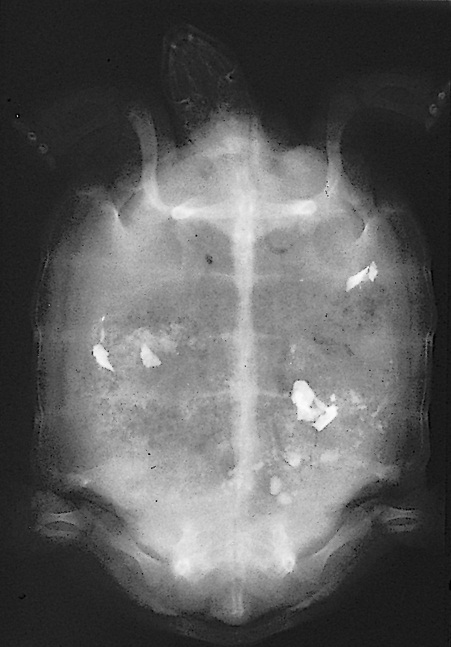Difference between revisions of "Reptiles and Amphibians Q&A 13"
Jump to navigation
Jump to search
Ggaitskell (talk | contribs) |
|||
| (One intermediate revision by the same user not shown) | |||
| Line 1: | Line 1: | ||
| + | {{Manson | ||
| + | |book = Reptiles and Amphibians Q&A | ||
| + | }} | ||
| + | |||
[[File:Rep 13.jpg|centre|500px]] | [[File:Rep 13.jpg|centre|500px]] | ||
| Line 11: | Line 15: | ||
|a1= | |a1= | ||
Multiple metallic objects are present in the alimentary tract. These were found to be chips of lead-based paint that caused lead poisoning. | Multiple metallic objects are present in the alimentary tract. These were found to be chips of lead-based paint that caused lead poisoning. | ||
| − | |l1= | + | |l1=Lead Poisoning |
|q2=How would you confirm your diagnosis? | |q2=How would you confirm your diagnosis? | ||
|a2= | |a2= | ||
Chemical determination of the amount of lead in the blood. The plasma contained 211mcg/dl of lead (control tortoise’s plasma – 25.7mcg/dl). | Chemical determination of the amount of lead in the blood. The plasma contained 211mcg/dl of lead (control tortoise’s plasma – 25.7mcg/dl). | ||
| − | |l2= | + | |l2=Lead Poisoning#Diagnosis |
|q3=What is your treatment of this disorder? | |q3=What is your treatment of this disorder? | ||
|a3= | |a3= | ||
| Line 21: | Line 25: | ||
Administer sodium calciumedetate (35mg/kg) daily for two weeks by slow intravenous infusion using a butterfly needle-set placed into the jugular vein). | Administer sodium calciumedetate (35mg/kg) daily for two weeks by slow intravenous infusion using a butterfly needle-set placed into the jugular vein). | ||
| − | |l3= | + | |l3=Lead Poisoning#Treatment |
</FlashCard> | </FlashCard> | ||
Latest revision as of 17:25, 28 October 2011
| This question was provided by Manson Publishing as part of the OVAL Project. See more Reptiles and Amphibians Q&A. |
This whole-body radiograph is of an adult desert tortoise, which was anorectic, anaemic, and clinically blind.
| Question | Answer | Article | |
| What is your diagnosis? | Multiple metallic objects are present in the alimentary tract. These were found to be chips of lead-based paint that caused lead poisoning. |
Link to Article | |
| How would you confirm your diagnosis? | Chemical determination of the amount of lead in the blood. The plasma contained 211mcg/dl of lead (control tortoise’s plasma – 25.7mcg/dl). |
Link to Article | |
| What is your treatment of this disorder? | Remove the lead fragments from the stomach with an endoscope and long forceps. Administer sodium calciumedetate (35mg/kg) daily for two weeks by slow intravenous infusion using a butterfly needle-set placed into the jugular vein). |
Link to Article | |
